Noble butterfly
| Noble butterfly | ||||||||||||
|---|---|---|---|---|---|---|---|---|---|---|---|---|

Peacock butterfly ( Inachis io ) |
||||||||||||
| Systematics | ||||||||||||
|
||||||||||||
| Scientific name | ||||||||||||
| Nymphalidae | ||||||||||||
| Rafinesque , 1815 |
The noble butterflies ( Nymphalidae) are a family of the order of the butterflies (Lepidoptera). Some of the most colorful butterflies in Europe belong to this large family, comprising around 6000 species worldwide . Among these species are numerous well-known representatives of butterflies such as B. Peacock butterfly ( Inachis io ) and small fox ( Aglais urticae ) can be found.
features



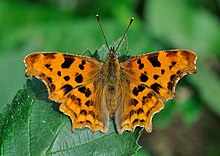


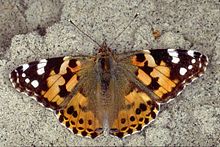
The moths reach a wingspan of 40 to 100 millimeters. They have wide fore wings that are only 1.4 to 1.9 times longer than wide. Their basic wing colors are mostly: dark brown, orange brown, yellow brown, yellow, red, blue, violet or black; the individual subfamilies differ from one another in their coloring, however. So have z. B. especially the ospreys (Satyrinae) eye spots on the wings and the Palearctic representatives of the Heliconiinae can be recognized by the mother-of-pearl spots on the underside of their wings ( mother-of-pearl ). The piebald butterflies (Melitaeini) have a characteristic black and orange pattern. All noble butterflies have common features that distinguish them from all other butterfly families (synapomorphies): They have elongated grooves ( carinae ) running along the underside over all segments of the antennae , between which there are two continuous depressions or shallow hollows. In addition, her first pair of legs is stunted ("cleaning paws"). This is more pronounced in the males, which is why in some species the sexes can be distinguished in this way. With these stumps they can only clean themselves, they only sit on four legs.
Your antennae are about half as long as the fore wing length and are club-shaped at the end. Besides their compound eyes, the moths have no point eyes ( ocelli ). They have reduced, one-unit jaw palps ( maxillary palps ) and their three-segment lip palps ( labial palps ) are directed upwards. The non-scaled proboscis is fully developed.
Their forewings have twelve wing veins and only one anal vein (1b). The hind wings have nine veins and two anal veins (1a and 1b). You are missing core 1c.
Characteristics of the caterpillars
The caterpillars usually have numerous thorns, which can also be branched. But there are also species whose caterpillars have long hair. Some species live gregariously in groups on the forage plants.
Way of life
The caterpillars feed on different plant families, such as B. of violet plants (Violaceae), nettle plants (Urticaceae), elm plants (Ulmaceae), willow plants (Salicaceae), hemp plants (Cannabaceae), honeysuckle plants (Caprifoliaceae) and others. The caterpillars of Julia Butterfly eat preferably fresh (Poaceae) and sour grasses (Cyperaceae).
development
The eggs of the noble butterfly are spherical and are either grooved or have a reticulate structure. Pupation takes place as falling pupae , which often have bumps and in many species have shiny metallic spots.
Systematics
Many subfamilies, namely the ophthalmic butterflies (Satyrinae), the Morphinae, the Libytheinae, the Danainae and others were classified as separate families in the older literature (and some entomologists still use them today). Lately the view seems to gain acceptance to classify them as subfamilies of the Monophylum Nymphalidae. According to this, the family is divided into up to twelve subfamilies, seven of which with 115 species occur in the German-speaking area (D, CH, A). In all of Europe they occur with 244 species and subspecies. The focus of their biodiversity is in the tropics of South America .
Central European species
Subfamily Libytheinae ( Schnauzenfalter )
- Hackberry butterfly , Libythea celtis ( Laicharting , 1782) CH-A
Subfamily Heliconiinae (passion flower butterfly)
- Tribus Argynnini ( mother-of-pearl butterfly )
- Imperial coat , Argynnis paphia ( Linnaeus , 1758) D-CH-A
- Cardinal , Argynnis pandora ( Denis & Schiffermüller , 1775) D-CH-A
- Eastern mother-of-pearl butterfly , Argynnis laodice ( Pallas , 1771) D.
- Large mother-of-pearl butterfly , Speyeria aglaja ( Linnaeus , 1758) D-CH-A
- Fiery mother-of-pearl butterfly , Fabriciana adippe ( Denis & Schiffermüller , 1775) D-CH-A
- Middle mother-of-pearl butterfly , Fabriciana niobe ( Linnaeus , 1758) D-CH-A
- Small mother-of-pearl butterfly , Issoria lathonia ( Linnaeus , 1758) D-CH-A
- Meadowsweet mother-of-pearl butterfly , Brenthis ino ( Rottemburg , 1775) D-CH-A
- Blackberry mother-of-pearl butterfly , Brenthis daphne ( Denis & Schiffermüller , 1775) D-CH-A
- Saumfleck mother-of-pearl butterfly , Brenthis hecate ( Denis & Schiffermüller , 1775) A.
- Rim-ring mother-of-pearl butterfly , Boloria eunomia ( Esper , 1799) DA
- Silberfleck-Perlmuttfalter , Boloria euphrosyne ( Linnaeus , 1758) D-CH-A
- Brown-spotted mother-of-pearl butterfly , Boloria selene ( Denis & Schiffermüller , 1775) D-CH-A
- Lean-grass mother-of-pearl butterfly , Boloria dia ( Linnaeus , 1767) D-CH-A
- Natterwurz mother-of-pearl butterfly , Boloria titania ( Esper , 1793) D-CH-A
- Alpine mother-of-pearl butterfly , Boloria thore ( Hübner , 1803) D-CH-A
- Alpine mat mother-of-pearl butterfly , Boloria pales ( Denis & Schiffermüller , 1775) D-CH-A
- Similar mother-of-pearl butterfly , Boloria napaea ( Hoffmannsegg , 1804) D-CH-A
- High-moor mother-of-pearl butterfly , Boloria aquilonaris ( burin , 1908) D-CH-A
Subfamily Nymphalinae ( spotted butterfly )
- Tribe Nymphalini


- Admiral , Vanessa atalanta ( Linnaeus , 1758) D-CH-A
- Painted lady , Vanessa cardui ( Linnaeus , 1758) D-CH-A
- Peacock butterfly , Aglais io ( Linnaeus , 1758) D-CH-A
- Small fox , Aglais urticae ( Linnaeus , 1758) D-CH-A
- C-Falter , Polygonia c-album ( Linnaeus , 1758) D-CH-A
- Southern C butterfly , Polygonia egea ( Cramer , 1775) CH
- Country map , Araschnia levana ( Linnaeus , 1758) D-CH-A
- Mourning cloak , Nymphalis antiopa ( Linnaeus , 1758) D-CH-A
- Big fox , Nymphalis polychloros ( Linnaeus , 1758) D-CH-A
- Eastern great fox , Aglais xanthomelas ( Esper , 1781) A.
- Nymphalis vaualbum ( Denis & Schiffermüller , 1775) A.
- Tribus melitaeini ( piebald butterfly )
- Ash butterfly , Euphydryas maturna ( Linnaeus , 1758) D-CH-A
- Violet Scheckenfalter , Euphydryas cynthia ( Denis & Schiffermüller , 1775) D-CH-A
- Honeysuckle Butterfly , Euphydryas intermedia ( Ménétries , 1859) D-CH-A
- Scabiosen-Scheckenfalter or Goldener Scheckenfalter, Euphydryas aurinia ( Rottemburg , 1775) D-CH-A
- Plantain-Scheckenfalter , Melitaea cinxia ( Linnaeus , 1758) D-CH-A
- Knapweed butterfly , Melitaea phoebe ( Denis & Schiffermüller , 1775) D-CH-A
- Brownish piebald butterfly , Melitaea trivia ( Denis & Schiffermüller , 1775) A.
- Red Scheckenfalter , Melitaea didyma ( Esper , 1778) D-CH-A
- Valerian-Scheckenfalter , Melitaea diamina ( Lang , 1789) D-CH-A
- Quail Wheat Scheckenfalter or Common Scheckenfalter, Melitaea athalia ( Rottemburg , 1775) D-CH-A
- Ehrenpreis-Scheckenfalter , Melitaea aurelia ( Nickerl , 1850) D-CH-A
- Eastern piebald butterfly , Melitaea britomartis ( Assmann , 1847) D-CH-A
- Western pied butterfly , Melitaea parthenoides ( Keferstein , 1851) D-CH
- Toadflax , Melitaea deione ( Geyer , 1832) CH
- Bündner Scheckenfalter , Melitaea varia ( Herrich-Schäffer , 1851) CH-A
- Little Scheckenfalter , Melitaea asteria ( Freyer , 1828) CH-A
Subfamily Limenitidinae ( Kingfishers )


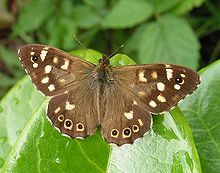
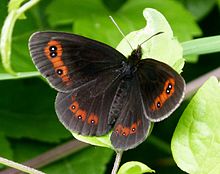
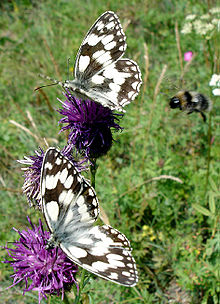

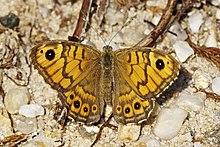

- Tribe Limenitidini
- Big kingfisher , Limenitis populi ( Linnaeus , 1758) D-CH-A
- Small kingfisher , Limenitis camilla ( Linnaeus , 1764) D-CH-A
- Blue-black kingfisher , Limenitis reducta ( Staudinger , 1901) D-CH-A
- Tribe Neptini
- Black-and-brown moth , Neptis sappho ( Pallas , 1771) A.
- Black pied butterfly , Neptis rivularis ( Scopoli , 1763) CH-A
Subfamily Apaturinae ( Schiller butterfly )
- Little Schiller butterfly , Apatura ilia ( Denis & Schiffermüller , 1775) D-CH-A
- Greater Schiller Butterfly , Apatura iris ( Linnaeus , 1758) D-CH-A
Subfamily Satyrinae ( Augenfalter )
- Tribe Elymniini
- Forest board game , Pararge aegeria ( Linnaeus , 1758) D-CH-A
- Wall fox , Lasiommata megera ( Linnaeus , 1767) D-CH-A
- Brown- tailed eye , Lasiommata petropolitana ( Fabricius , 1787) D-CH-A
- Brown eye , Lasiommata maera ( Linnaeus , 1758) D-CH-A
- Yellow-ringed butterfly , Lopinga achine ( Scopoli , 1763) D-CH-A
- Tribe Coenonymphini
- Large meadow bird , Coenonympha tullia ( Müller , 1764) D-CH-A
- Stromtal meadow bird , Coenonympha oedippus ( Fabricius , 1787) D-CH-A
- White-headed meadow bird , Coenonympha arcania ( Linnaeus , 1761) D-CH-A
- Red-brown meadow bird , Coenonympha glycerion ( Borkhausen , 1788) D-CH-A
- Alpine meadow bird , Coenonympha gardetta ( De Prunner , 1798) D-CH-A
- Darwin's meadow bird , Coenonympha darwiniana Staudinger , 1871 CH-A, species status disputed
- Forest meadow bird , Coenonympha hero ( Linnaeus , 1761) D-CH-A
- Small meadow bird , Coenonympha pamphilus ( Linnaeus , 1758) D-CH-A
- Tribe Maniolini
- Red-brown ox-eye , Pyronia tithonus ( Linnaeus , 1767) D-CH
- Brown forest bird or chimney sweep, Aphantopus hyperantus ( Linnaeus , 1758) D-CH-A
- Great ox-eye , Maniola jurtina ( Linnaeus , 1758) D-CH-A
- Small ox-eye , Hyponephele lycaon ( Rottemburg , 1775) D-CH-A
- Tribe Erebiini
- White-beaded Mohrenfalter , Erebia ligea ( Linnaeus , 1758) D-CH-A
- Weißbindiger Bergwald-Mohrenfalter , Erebia euryale ( Esper , 1805) D-CH-A
- Similar Mohrenfalter , Erebia eriphyle ( Freyer , 1836) D-CH-A
- Yellow-spotted Mohrenfalter , Erebia manto ( Denis & Schiffermüller , 1775) D-CH-A
- White-banded Mohrenfalter , Erebia bubastis ( Meisner , 1818) CH
- White- dotted Mohrenfalter , Erebia claudina ( Borkhausen , 1789) A.
- Yellow-banded Mohrenfalter , Erebia flavofasciata ( Heyne , 1895) CH-A
- Knoch's Mohrenfalter , Erebia epiphron ( Knoch , 1783) D-CH-A
- Rätzer's Mohrenfalter , Erebia christi ( Rätzer , 1890) CH
- Unpunctured Mohrenfalter , Erebia pharte ( Hübner , 1804) D-CH-A
- Little Mohrenfalter , Erebia melampus ( Fuessly , 1775) D-CH-A
- Sudeten Mohrenfalter , Erebia sudetica ( Staudinger , 1861) CH
- Graubindiger Mohrenfalter , Erebia aethiops ( Esper , 1777) D-CH-A
- Alpine Mohrenfalter , Erebia triaria ( De Prunner , 1798) CH
- Round-eyed Mohrenfalter , Erebia medusa ( Denis & Schiffermüller , 1775) D-CH-A
- Almond-eyed Mohrenfalter , Erebia alberganus ( De Prunner , 1798) CH-A
- Eis-Mohrenfalter , Erebia pluto ( De Prunner , 1798) D-CH-A
- Rock Mohrenfalter , Erebia gorge ( Hübner , 1804) D-CH-A
- Blindpunkt-Mohrenfalter , Erebia mnestra ( Hübner , 1804) CH-A
- Iridescent Mohrenfalter , Erebia tyndarus (Esper, 1781) D-CH-A
- High alpine iridescent Mohrenfalter , Erebia nivalis Lorković & Lesse , 1954 CH-A
- Lorkovics Mohrenfalter , Erebia calcaria Lorković , 1953 A
- Erebia cassioides ( Reiner & Hochenwarth , 1792) A.
- Erebia arvernensis ( Oberthür , 1908) CH
- Wasser-Mohrenfalter , Erebia pronoe ( Esper , 1780) D-CH-A
- White-tailed Mohrenfalter , Erebia stirius ( Godart , 1824) A.
- Freyers Alpen-Mohrenfalter , Erebia styx ( Freyer , 1834) D-CH-A
- Marbled Mohrenfalter , Erebia montana ( De Prunner , 1798) CH-A
- Doppelaugen-Mohrenfalter , Erebia oeme ( Hübner , 1804) D-CH-A
- Yellow- bound Mohrenfalter , Erebia meolans ( De Prunner , 1798) D-CH-A
- Graubrauner Mohrenfalter , Erebia pandrose ( Borkhausen , 1788) D-CH-A
- Melanargiini tribe
- Chessboard , Melanargia galathea ( Linnaeus , 1758) D-CH-A
- Tribe Satyrini
- White-tailed eye , Satyrus ferula ( Fabricius , 1793) CH
- Blue-eyed forest porter , Minois dryas ( Scopoli , 1763) D-CH-A
- Large forest porter , Hipparchia fagi ( Scopoli , 1763) D-CH-A
- Small forest porter , Hipparchia alcyone ( Denis & Schiffermüller , 1775) D-CH-A
- Walliser forest porter , Hipparchia genava ( Fruhstorfer , 1908) CH
- Ocher-bound velvet butterfly , Hipparchia semele ( Linnaeus , 1758) D-CH-A
- Iron- colored velvet butterfly , Hipparchia statilinus ( Hufnagel , 1766) D-CH-A
- Red-bound velvet butterfly , Arethusana arethusa ( Denis & Schiffermüller , 1775) D-CH-A
- White forest porter , Brintesia circe ( Fabricius , 1775) D-CH-A
- Mountain witch , Chazara briseis ( Linnaeus , 1764) D-CH-A
- Glacier butterfly , Oeneis glacialis ( Moll , 1783) D-CH-A
Subfamilies, tribes and species not found in Central Europe (selection)
- Subfamily Apaturinae
- Subfamily Biblidinae
- Subfamily Calinaginae
- Subfamily Charaxinae
- Anaeini tribe
- Tribe Charaxini
- Strawberry Tree Butterfly , Charaxes jasius (Linnaeus, 1766)
- Subfamily Cyrestinae
- Subfamily Danainae
- Tribe Danaini
- White tree nymph , Idea leuconoe (Erichson, 1834)
- Monarch , Danaus plexippus (Linnaeus, 1758)
- Euploea core (Cramer, 1780)
- Tirumala limniace (Cramer, 1775)
- Ithomiini tribe
- Greta nero
- Greta oto (glass winged butterfly)
- Tribe Danaini
- Subfamily Satyrinae
- Tribus Brassolini
- Caligo eurilochus (Cramer, 1775)
- Tribus Morphini (Morphofalter, Himmelsfalter)
- Blue morpho butterfly , Morpho peleides Kollar, 1850
- Morpho rhetenor (Cramer, 1775)
- Tribe Satyrini
- Canary forest board game , Pararge xiphioides (Staudinger, 1871)
- Aulocera swaha Kollar, 1844: north of the Indian Ocean / Himalaya
- Subfamily Heliconiinae
- Tribus Heliconiini ( passion flower butterfly )
- Zebra butterfly , Heliconius charithonia (Linnaeus, 1767)
- Little Courier , also Little Postman , Heliconius erato (Linnaeus 1758)
- Heliconius sara (Fabricius, 1793)
- Agraulis vanillae (Linnaeus, 1758)
- Cirrochroa thais (Fabricius, 1787)
- Tribe Acraeini
- Vagrantini tribe
- Tribus Heliconiini ( passion flower butterfly )
- Subfamily Nymphalinae (spotted butterfly)
- Junoniini tribe
- Hypolimnas bolina (Linnaeus, 1763)
- Junonia atlites (Linnaeus, 1763)
- Junonia coenia (Huebner, 1822)
- Junonia goudotii (Boisduval, 1833)
- Junonia hierta (Fabricius, 1793)
- Junonia orithya (Linnaeus, 1758)
- Junonia rhadama (Boisduval, 1833)
- Junonia sophia (Fabricius, 1798)
- Protogoniomorpha parhassus (Drury, 1782)
- Precis archesia
- Precis octavia
- Yoma sabina
- Tribus Melitaeini
- Tribe Nymphalini
- Aglais milberti (Godart, 1819)
- Antanartia borbonica (Oberthür, 1879)
- Colobura dirce (Linnaeus, 1758)
- Hypanartia lethe
- Indian admiral , Vanessa indica (autumn, 1794)
- Canarian admiral , Vanessa vulcania (Godart, 1819)
- Tribus Victorini
- Junoniini tribe
- Subfamily Limenitidinae
- Athyma asura
- Athyma cama
- Athyma perius
- Athyma ranga
- Bassarona dunya
- Catacroptera cloanthe
- Dophla evelina
- Euthalia aconthea
- Euthalia anosia
- Euthalia formosana
- Euthalia irrubescens
- Euthalia lubentina
- Euthalia nais
- Euthalia phemius
- Hamanumida daedalus
- Lexias pardalis
- Moduza procris
- Neptis frobenia
- Parasarpa dudu
- Sumalia daraxa
- Parthenus
swell
Individual evidence
- ↑ Nymphalidae. Lepiforum eV, accessed on February 21, 2007 .
- ↑ Nymphalidae. Fauna Europaea, accessed February 21, 2007 .
